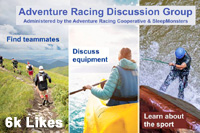Das Boot
Adam Rose / 06.09.2019



OK, let’s talk about the crux of Expedition Africa Rodrigues: the Floating Vessels of Dooom!! (cue thundering chords and howls to the moon).
It was interesting to discuss them with teams after they had hands-on experience, compared to their preconceptions. In a nutshell, overall positive.
The boats have made the race possible in this confined area. If conventional land transitions had been used, the logistics would have been impossible with so many locations. The roads would have been jammed with trucks, lorries, vans and pickups, engines overheating, pressure building, tempers rising, and could possibly have led to disease outbreaks, famine and pestilence! Luckily Stephan saw a shining path through this civil meltdown, and it means the most complex race in AR history is winding down to a successful completion. Whew! So close.
Boats meant there was only ONE transition, despite the rumours. Nothing had to be hauled from A to B by anyone other than the racers. That meant they couldn’t possibly forget anything because it all travelled with them.
Or did it?
Herewith a major thorn in the side of many teams: wading for forgetfulness. When a team docked their boat, it had to be in water deep enough to avoid tidal stranding. You grab all your gear, head ashore, suit up for your discipline, start the hike or bike or sleep and…….doh! Who’s going to fetch the (insert essential kit here)?! And if your feet touched the water, you had to be wearing shoes to avoid a 1hr penalty, so a real hassle.
Tweet was typically direct in his response to those who found this challenging: “Poor planning”. He’s not wrong at all, but the pain was real.
The second gripe was having to fetch said boat on return to TA. Who’s already got wet feet? Off you go, Wade!
Some of the boat troubles started right early. Into The Unknown (35), comprised of a captain and 3 expedition newbies, set off in the regatta with an over-excited skipper. Ironically ITU’s symbol was the pirate flag they carried. Said skipper immediately crashed his mighty ship into a competitor, and sank! The 4 team members were left floundering in the water, having to dive down to retrieve gear. One saw fins floating around and grabbed them. “What should I do with them?!”
His team, “Put them on! Put them on!”
They then missed their 3 snorkelling CPs, lacking a boat to get to them – what a hectic start to one’s first expedition experience. “Is this normal?!”
The Boat could be a bit challenging when fatigued:
- Wild Island Style overshot T9
- Bloed & Omo Fresh overshot T9 by several kilometres.
- Merrell Mentored Missiles slept on Catherine Island, then had to paddle back to T7 to retrieve forgotten helmets required on the next land stage.
- Shnazen Hazen (38) got to T8 on Coco island, then realised they hadn’t dibbed on Catherine Island, had to paddle back, then return to T8.
- another team paddled to T6 instead of T5.
These are only the ones I know about.
Nyamezela experienced an existential crisis at transition, “mind blank, dribbling”, staring. What to return to the boat? No idea. What is boat?
The boats, when equipped with functioning sails, were a completely different experience. Plett AR saw Greener Adventure Team stream past them to T7, as Plett AR were swimming back from Crab Island. Someone was sleeping, another steering with a paddle, and the other two brewing coffees to enjoy in the morning breeze. Effortless downwind tripping.
Nyamezela found the same leg to T7 highly enjoyable, Kim producing wraps on the blade of her paddle, with sun-dried tomatoes in olive oil (Woolies finest), delectable cheese (Woolies again) and chilli sauce, no-one else needing to lift a finger for forward propulsion. (They also felt guilty for nabbing a spring onion from a farmer’s field to flavour some BBQ meat brought at a roadside stall. The spring onion was forgotten, and still lay trapped somewhere in the “rancid mess of her bag”).
Bloed & Omo Fresh used a trapezoid tarp, 4 lines and a paddle to steer the sail. Result: barely a minute’s paddling towards T8. Very impressive.
The Russians claimed their best decision for the race was their sail system. It saved strength, gave them rest, and allowed them to do constructive tasks.
Plett AR seemed a little peeved. Maybe it was the lack of sleep, general fatigue, or plain rabid envy, but after seeing GAT sail so easily, ventured that it was a different race for those teams with an effective sail system. Unfair? Not really, because some of the best solutions were very cheap. It wasn’t a finance issue. Hanno Smit of Merrell thought the layout of the sailing was nicely balanced with non-sailing stages, so that those who didn’t have sails had a chance to get back into competition.
Another boat curve was that your transition could disappear. More than a few teams had their boats drift off, whether due to failed anchors, or loose ropes, or user error. Or even not lose the boat, but just struggle to find it at a besieged transition. Tidal shift, boats drift, in the dark of night.
Boats meant TIME, because boats meant tides. Many races have sea legs, where tide plays a role, but for it to be influential for every transition, and often decisive in handicapping teams, was another level. This combined with the relative lack of sailing and swimming experience across the field, was a great leveller, said Dawie from Namaqua. It brought in a chaos factor for most teams.
The enforced delays of being stuck fast weren’t all bad. Winging It Island Style’s Kim Brown said of the team’s enforced stay on Coco Island overnight, “Thank you to Heidi and Stephan for reminding me what a galaxy looks like.” Stunning.
Team Merrell took a sleep from T4 to T5. Blizzard and GAT did the same on other legs. It forced them to rest when they might otherwise have pushed too hard, especially mentally.
The boats also brought a critical element to the fore: organisation. If your boat wasn’t sorted, it made things harder to find, which meant longer transitions, and there were many of those. Time and again teams raised the point, about the logistical complexity of the boats, with a few preferring the ordinary gear boxes of previous expedition races. Only a few, because the overwhelming feedback was that the boats made for a far more exciting race, and teams would be back if given the option in future races.
Graham Bird found, unexpectedly, that the boats led to a simplified race. They were reduced to essentials as the race wore on, and due to the frequent immersions, most of Team Merrell only used one pair of socks and one pair of shorts the entire expedition. No foot issues, no chaffing issues, thanks to preventative measures, which even then weren’t drastic.
Australian Richard Old from Fully Rad Adventures (27), an accomplished race director himself, really liked the boats and the tidal element. He also saw them as the biggest obstacle to full course completion, but as I write, there are currently 25 teams expected to achieve it, out of 60.
A common comment was how the boats were easier to move than anticipated. They had momentum once moving, even upwind. Notwithstanding, Into the Unknown (35) were paddling their bikes to T10, moving at about 1 knot into the wind. Then one carbon paddle snapped, the boat immediately swung around, and they couldn’t correct it. Stuck in reverse, one grabbed a long pole they’d had in the boat all along and started punting, backwards. They suddenly started moving at 3-4 knots, making much better progress, and disappeared from the view of neighbouring teams.
So, boats would appear to be here to stay, particularly in a tropical island setting as we had on Rodrigues. In a cold climate, constantly freezing, it might have lead to mutiny, but they’re surely going to be the most remembered element of an incredible event.








 SleepMonsters
SleepMonsters



